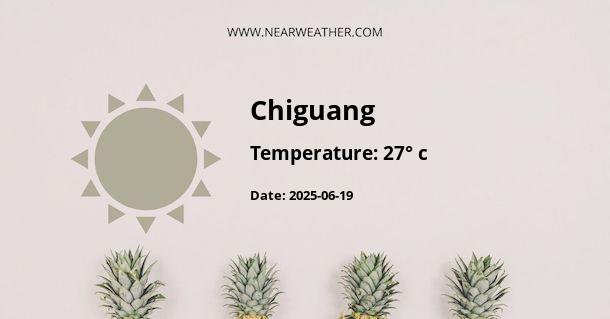Climate and Weather in Chiguang, China
Chiguang, located in the Guangdong province of China, experiences a subtropical monsoon climate. The region is characterized by its hot and humid summers, mild winters, and abundant rainfall throughout the year. Understanding the climate and weather patterns in Chiguang is crucial for residents, tourists, and businesses in the area.
Temperature
Chiguang's average annual temperature is around 22 degrees Celsius (71.6 degrees Fahrenheit). Summers are hot and muggy, with temperatures reaching an average high of 32 degrees Celsius (89.6 degrees Fahrenheit) in July and August. Winters, on the other hand, are mild and pleasant, with average highs of 19 degrees Celsius (66.2 degrees Fahrenheit) in January and February.
The temperature variation between day and night is relatively small throughout the year, thanks to the region's proximity to the South China Sea, which helps moderate the temperature. However, it is important to note that extreme heatwaves or cold spells can occur occasionally.
Rainfall
Chiguang receives abundant rainfall throughout the year, with an average annual precipitation of approximately 1,800 millimeters (70.9 inches). The wettest months are from April to September, with May and June being the peak months for rainfall. During this period, Chiguang experiences frequent showers and occasional thunderstorms.
The monsoon season in Chiguang contributes significantly to the rainfall. The region is affected by both the northeast monsoon, which brings cooler and drier air from the continent, and the southwest monsoon, which brings warm and moist air from the South China Sea. These monsoons result in the high precipitation levels experienced in Chiguang.
Sunshine
Chiguang enjoys a moderate amount of sunshine, with an average of 1,800 to 2,200 hours of sunshine annually. The sunniest months are from October to December, while the cloudiest months are from April to September. The presence of clouds during the wet season can reduce the amount of sunlight reaching the region.
Typhoons
Chiguang is susceptible to typhoons due to its coastal location. Typhoon season typically occurs from May to November, with the highest frequency between July and September. These powerful tropical cyclones can bring strong winds, heavy rainfall, and storm surges to the region.
It is important for residents and visitors to closely monitor weather reports and follow any instructions or warnings issued by local authorities during typhoon events. Adequate preparation and precautions are necessary to ensure safety.
Best Time to Visit
The best time to visit Chiguang is during the spring (March to May) and autumn (September to November) seasons. During these periods, the weather is generally mild and comfortable, with less rainfall compared to the summer months.
Spring brings pleasant temperatures and blooming flowers, making it an ideal time for outdoor activities and sightseeing. Autumn offers similar advantages, with cooler temperatures and colorful foliage.
However, it is important to note that weather conditions can vary from year to year, and it is always recommended to check the latest weather forecasts before planning a trip to Chiguang.
Conclusion
Chiguang's subtropical monsoon climate offers hot and humid summers, mild winters, and abundant rainfall throughout the year. The region experiences a moderate amount of sunshine but is susceptible to typhoons during the typhoon season. The best time to visit Chiguang is during the spring and autumn seasons when the weather is mild and comfortable. Understanding the climate and weather patterns in Chiguang is essential for residents, tourists, and businesses to plan their activities and make informed decisions.
A - Chiguang's Latitude is 24.386299 & Longitude is 115.431038.
A - Weather in Chiguang is 26° today.
A - Climate Conditions in Chiguang shows overcast clouds today.
A - Humidity in Chiguang is 73% today.
A - Wind speed in Chiguang is 6.12 km/h, flowing at 346° wind direction. today.
